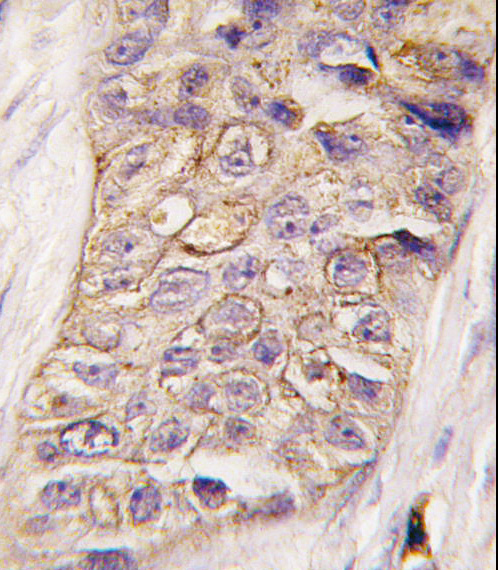PI3KC2B Antibody (N-term)
Purified Rabbit Polyclonal Antibody (Pab)
- SPECIFICATION
- CITATIONS
- PROTOCOLS
- BACKGROUND

Application
| WB, IHC-P, E |
|---|---|
| Primary Accession | O00750 |
| Reactivity | Human |
| Host | Rabbit |
| Clonality | Polyclonal |
| Isotype | Rabbit IgG |
| Calculated MW | 184768 Da |
| Antigen Region | 120-150 aa |
| Gene ID | 5287 |
|---|---|
| Other Names | Phosphatidylinositol 4-phosphate 3-kinase C2 domain-containing subunit beta, PI3K-C2-beta, PtdIns-3-kinase C2 subunit beta, C2-PI3K, Phosphoinositide 3-kinase-C2-beta, PIK3C2B |
| Target/Specificity | This PI3KC2B antibody is generated from rabbits immunized with a KLH conjugated synthetic peptide between 120-150 amino acids from the N-terminal region of human PI3KC2B. |
| Dilution | WB~~1:1000 IHC-P~~1:10~50 E~~Use at an assay dependent concentration. |
| Format | Purified polyclonal antibody supplied in PBS with 0.09% (W/V) sodium azide. This antibody is prepared by Saturated Ammonium Sulfate (SAS) precipitation followed by dialysis against PBS. |
| Storage | Maintain refrigerated at 2-8°C for up to 2 weeks. For long term storage store at -20°C in small aliquots to prevent freeze-thaw cycles. |
| Precautions | PI3KC2B Antibody (N-term) is for research use only and not for use in diagnostic or therapeutic procedures. |
| Name | PIK3C2B |
|---|---|
| Function | Phosphorylates PtdIns and PtdIns4P with a preference for PtdIns (PubMed:10805725, PubMed:11533253, PubMed:9830063). Does not phosphorylate PtdIns(4,5)P2 (PubMed:9830063). May be involved in EGF and PDGF signaling cascades (PubMed:10805725). |
| Cellular Location | Microsome. Cell membrane. Cytoplasm, cytosol Nucleus. Endoplasmic reticulum. Note=Found mostly in the microsome, but also in the plasma membrane and cytosol. Nuclear in testis |
| Tissue Location | Expressed in columnar and transitional epithelia, mononuclear cells, and ganglion cells (at protein level). Widely expressed, with highest levels in thymus and placenta and lowest in peripheral blood, skeletal muscle and kidney |

Thousands of laboratories across the world have published research that depended on the performance of antibodies from Abcepta to advance their research. Check out links to articles that cite our products in major peer-reviewed journals, organized by research category.
info@abcepta.com, and receive a free "I Love Antibodies" mug.
Provided below are standard protocols that you may find useful for product applications.
Background
Protein kinases are enzymes that transfer a phosphate group from a phosphate donor, generally the g phosphate of ATP, onto an acceptor amino acid in a substrate protein. By this basic mechanism, protein kinases mediate most of the signal transduction in eukaryotic cells, regulating cellular metabolism, transcription, cell cycle progression, cytoskeletal rearrangement and cell movement, apoptosis, and differentiation. With more than 500 gene products, the protein kinase family is one of the largest families of proteins in eukaryotes. The family has been classified in 8 major groups based on sequence comparison of their tyrosine (PTK) or serine/threonine (STK) kinase catalytic domains.
References
Arcaro, A., et al., J. Biol. Chem. 273(49):33082-33090 (1998).
Brown, R.A., et al., Biochem. Biophys. Res. Commun. 233(2):537-544 (1997).
If you have used an Abcepta product and would like to share how it has performed, please click on the "Submit Review" button and provide the requested information. Our staff will examine and post your review and contact you if needed.
If you have any additional inquiries please email technical services at tech@abcepta.com.













 Foundational characteristics of cancer include proliferation, angiogenesis, migration, evasion of apoptosis, and cellular immortality. Find key markers for these cellular processes and antibodies to detect them.
Foundational characteristics of cancer include proliferation, angiogenesis, migration, evasion of apoptosis, and cellular immortality. Find key markers for these cellular processes and antibodies to detect them. The SUMOplot™ Analysis Program predicts and scores sumoylation sites in your protein. SUMOylation is a post-translational modification involved in various cellular processes, such as nuclear-cytosolic transport, transcriptional regulation, apoptosis, protein stability, response to stress, and progression through the cell cycle.
The SUMOplot™ Analysis Program predicts and scores sumoylation sites in your protein. SUMOylation is a post-translational modification involved in various cellular processes, such as nuclear-cytosolic transport, transcriptional regulation, apoptosis, protein stability, response to stress, and progression through the cell cycle. The Autophagy Receptor Motif Plotter predicts and scores autophagy receptor binding sites in your protein. Identifying proteins connected to this pathway is critical to understanding the role of autophagy in physiological as well as pathological processes such as development, differentiation, neurodegenerative diseases, stress, infection, and cancer.
The Autophagy Receptor Motif Plotter predicts and scores autophagy receptor binding sites in your protein. Identifying proteins connected to this pathway is critical to understanding the role of autophagy in physiological as well as pathological processes such as development, differentiation, neurodegenerative diseases, stress, infection, and cancer.


